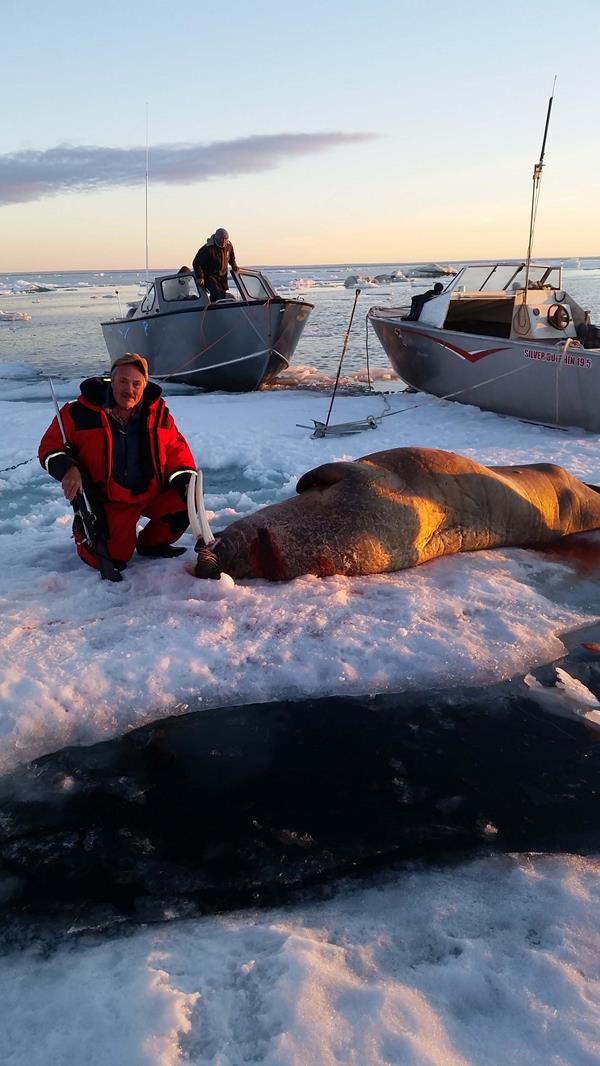
Like a hound hunt for mountain lions, the actual shot is anticlimactic. The real hunt is in the anticipation of and traveling first to Nunavut and then out onto the Arctic Ocean to pursue the Atlantic walrus on the ice flows where they haul-out to digest their diet of deep-water clams.
I began preparations for the hunt months in advance. Gear check. Review whether or not Arctic char fishing is open. Re-zero my faithful .338 Win. Mag. to 50 yards. Check the baggage allotments for First North Air [two free bags]. The list goes on. I elected to drive to Ottawa rather than fly. The Canadian Customs and Border constabulary have gotten out-of-hand when entering their country by air. I’ve missed flights several times and stressed out on all recent Canada trips when I nearly missed domestic Canadian flights. Assuming your paperwork is in order, driving across is far easier. The bottom line for me was that I could drive there quicker and with less stress than I could fly.
I arrived in Hall Beach, Nunavut with three other hunters and Shane on July 11, 2018. We stayed at an Inuit-operated hotel cooperative with Wi-Fi, satellite television, and good food. It was not a Spartan existence. The next day, it blew hard out of the southeast. Offshore pack ice raced by. The head local guide, Enoki Inuaraq, treated us to a trip to his fishing camp. He set a gill net for Arctic char while we enjoyed viewing the tundra birds, hot tea, and a lot of conversation. The topper was a great homemade caribou stew and fried bannock made on a Coleman stove by his wife, Ruthie. We got our money’s worth from our Nunavut fishing licenses, casting into the surf. If you’re forced to kill some time, this is a very good way to do it.
These are not Wal-Mart Inuit. They are not conflicted in any cultural way. While we drove to the camp in an SUV, they would filet and air-dry their fish by hand with the practiced ease of a lifetime of experience. We ate dried char like snack food. They knew the names and niche of nearly every bird that flew by. The last thing that went in the vehicle before leaving town was the insurance rifle, a WWII British Enfield in .303 caliber. Never leave home without one, especially when you have a bunch of flatlanders in tow.
The following day also started windy and, according to Enoki at breakfast, did not hold much promise for ocean boat travel. Just before lunch, he reappeared and announced a 1:00 p.m. rendezvous time. The hunt was on. Each hunter had his own guide, boat, and two or three assistants. The boats ranged from 19.5 to 25 feet long and were propelled by big, new engines. Most had twin outboard engines. Additionally, there was a fifth boat for emergencies. There were 20 souls in all, including the hunters. It was a complicated, logistical endeavor to get that much rolling stock and men together and properly functioning. Enoki was equal to the task.
We headed toward blue water. There were big swells from the day before. While it wasn’t tooth filling looseningly rough, it was rough enough that you timed your knee bends. Nearly three hours later, we were out of sight of land when we found the big raft ice. Thereafter, it took another several hours to locate any walrus.
Before I shot one, I wanted to see how they behaved, what “big” looked like, and so forth. Typically, the walrus did not dive in right away, although some females with 500 pound calves did lose their nerve and slide off the ice. Judging from the excrement on the ice flows holding walrus, they used the same ice repeatedly. We saw two polar bears, one swimming and another traversing the broken pack-ice. They too took little notice of our presence.
Gary Russell from Arkansas got the party started after supper by shooting a big male with heavy and uneven tusks. Fourteen men and women broke the walrus down in under an hour, from photos to clean up. Every Inuit had a preassigned job.
I was up next. We found a group of large males, and one seemed longer and heavier than most. I took it with one neck shot. It died instantly (thanks again to Dennis Duff Ordinance), and I had a great walrus. We were near the edge of the ice and the open ocean, but the wind and tide were closing up the leads between the ice blocks, so we attached a line to the walrus and pulled it off the ice and towed it to a larger block of ice on the edge of the flowage. Otherwise, we’d be locked in place until the tide changed in 12 hours.
They cut 3x3 foot sections of skin from the walrus. Then, they flensed the skin with 4-5” of blubber attached from the carcass. Next, they perforated the edge of the skin around the entire perimeter. They lashed the skin together with heavy nylon cord with the blubber on the inside. They packed the “bag” with meat and viscera and sewed it closed. My walrus yielded nine such bags of meat, plus the flippers, ribs, and intestines. Each bag weighed 100-150 pounds. They would bury it on the permafrost and dig it up in November/December
I shot my walrus after midnight. We traveled westerly into the sun, which we watched drop toward the horizon but not reach it then it reascended the heavens. We reached Hall Beach around 4:30 only to be greeted by a confused drifted ice pack blocking our progress. In the process of negotiating the final mile, we had dinged-up one aluminum propeller, and eventually made an amphibious landing a few hundred meters short of town. We slept in that morning. It had been a good day by Spear standards.